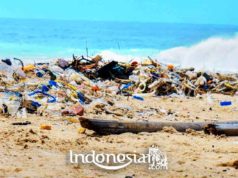Earthquake relocation recorded by Indonesia’s Agency for Meteorology, Climatology and Geophysics (BMKG) and inversion of global positioning system (GPS) data revealed a clear seismic gap in the south of Java island.
This raises the possibility related to the potential source of megathrust earthquakes that will occur in the future.
Megathrust earthquakes have a large impulse and occur in subduction zones at destructive convergent plate boundaries, where one tectonic plate is compressed under another.
Megathrust is also among the most powerful interlittal earthquakes on planet Earth, with recorded moments that can exceed magnitude 9.0.
This is disclosed in a scientific report entitled “Implications for megathrust earthquakes and tsunamis from seismic gaps south of Java Indonesia” released by Nature.com on Thursday (17/9/2020).
The scientific journal was written by 11 researchers from various universities and institutions at home and abroad. They are S. Widiyantoro (Global Geophysics Research Group, Faculty of Mining and Petroleum Engineering, Bandung Institute of Technology and Faculty of Engineering, Maranatha Christian University, Bandung), E Gunawan (ITB), and A Muhari (BNPB).
Others are N. Rawlinson (Department of Earth Sciences-Bullard Labs, University of Cambridge, Cambridge, UK), J. Mori (Disaster Prevention Research Institute, Kyoto University, Uji, Japan), NR Hanifa (National Center for Earthquake Studies, Bandung ), and S. Susilo (Geospatial Information Agency, Cibinong).
Then P. Supendi (BMKG, Bandung), H. A. Shiddiqi (Department of Earth Science, University of Bergen, Allègaten, Bergen, Norway), AD Nugraha (ITB), and HE Putra (PT Reasuransi Maipark, Jakarta).
In the scientific report, dated September 17, the researchers assessed the hazard by performing tsunami modeling based on several scenarios, involving a large tsunamigenic earthquake caused by a fracture along with segments of the megathrust in southern Java.
The results of the earthquake relocation carried out by the researcher showed a clear longitudinal zone, located between the coast of Java and the Java Trench, which had no earthquake frequency and was identified as a seismic gap.
The worst case scenario, where two segments of the megathrust covering Java, rupture simultaneously and suggest that the tsunami height could reach more than 20 meters and 12 meters on the south coast of West and East Java, respectively, with an average maximum height of 4.5 meters along the southern coast of Java.
The results of this study support the call to strengthen the existing Indonesian Tsunami Early Warning System, especially in Java, which is the most populous area in Indonesia.
Furthermore, the seismic gap off the southwest coast of Sumatra also risks creating future megathrust events.
In 2018, the government through the National Earthquake Study Center (PUSGEN), supported by earthquake experts from several universities, institutions and ministries including the BMKG, had published the book Map of the Sources and Hazards of the Indonesian Earthquake 2017 “as one of the efforts and steps earthquake mitigation in Indonesia.
The map is a guideline for designing building construction in earthquake-prone areas, taking into account ground acceleration due to earthquake wave propagation.
In the book, it is informed that the results of the studies of experts, namely regarding the collision zone between the Indo-Australian and Eurasian Plates, which sink under the Java Island or the megathrust zone, and the process of submerging the plates is still occurring at a rate of 60-70 mm per year.
According to the analysis of earthquake experts, the motion of the plate subduction is possible to cause a megathrust earthquake with a maximum strength / magnitude that is estimated to reach a magnitude of 8.7.
Source :cnbcindonesia
































